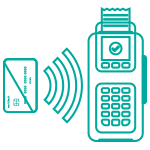In this modern digital age, we can see so many changes in every industry, especially in the restaurant business. With the help of these changes, the restaurant industry makes its operations very simple and easy.
What is Kot (Kitchen Order Ticket)?
A kitchen order ticket is created whenever an order is placed on the POS, it generates notes to the kitchen, billing, etc. These notes include table number, items ordered, and their quantity.
Kitchen Order Ticket implementation is one of the most powerful changes that happened in the restaurant industry. Now we can discuss automated Kitchen Order Tickets (KOT) here.

Instead of the traditional system, nowadays most restaurants have moved to use the latest technologies and they are using automated KOT. For that, they are installing POS systems on the food service desk and KOT printers installed in the kitchen.
In the traditional system, it was a long process; waiters took an order and one copy was forwarded to the kitchen, and the second copy was forwarded to the billing section. A third copy remains with the waiter for reference. Because of this, the paper KOT process has so many limitations. The main issues are that this is a manual process and there are many possibilities of errors occurring. Also, daily auditing was a very difficult process in this traditional system.
Also, check – What is Cloud Kitchen [Concept & Bussiness Model]
How does a KOT system in restaurants help the business?

1) Save time: As we know, the KOT application saves us a lot of time. Once the order is taken, then the order details are printed or displayed in the kitchen immediately. Also, staff can place orders from anywhere in the restaurant and these orders display immediately in the kitchen. So, the chef can prepare the items quickly based on priority. Once the items are prepared in the kitchen, the waiters are notified and it is served to the customer very fast. So that customers also get faster services.
2) Easy to use: Order taking with the help of POS is very easy because most POS systems are
touch screens. Also, once an order is placed then KOT is automatically generated. So, staff can easily use this feature without a long-time training.
3) Real-time report: With the help of a cloud-based restaurant system, restaurant owners can track the real-time reports related to KOT from anywhere, and based on that, they can make decisions easily, even if they have outlets at multiple locations also.
4) Reduce errors: In traditional systems, generally, orders are forwarded to the kitchen verbally or through handwritten copies. This may create issues because of poor communication, bad handwriting, etc. With the help KOT system, we can avoid these issues.
5) Reduce labor cost: If you are using a traditional system, the waiter/staff needs to check the order again and again the KOT. An automated system, it reduces manual tasks, and errors, so we can reduce labor costs.
6) Reduce the wastage: By using an automated KOT application, every order can be displayed through KDS in the kitchen, so this will help chefs to avoid extra food preparations and food wastage.
7) Streamlines the order process: While peak hours and weekends, restaurants need to handle many orders without missing anything. With the help of a KOT application, you can display new orders or add them to the queue. So, waiters or kitchen staff can continuously work without missing any orders. If the POS system is integrated with online orders from different online platforms, then with the help of an automated KOT application KOT is immediately generated. So, restaurants can provide fast service without missing any orders.
Also, read –
What is Menu Engineering?
60+ Unique Cafe Names in India That are Catchy

Different Types of KOT Used By Restaurants
RETOUR(return)
Sometimes, when the restaurants send the wrong order to the table and replace it after taking it back from the table to the kitchen, this KOT is raised. This KOT is also known as the EN PLACE KOT. Restaurants also raise this KOT when a guest returns a particular dish because it is spoiled and orders a replacement of the same dish or a new dish.
This KOT contains similar data to traditional KOT, but only the two dishes guests have returned and replaced are marked with the word “RETOUR( return).” The restaurant charged only one dish at a lower price.
SUIVANT
This KOT is similar to the traditional KOT, but on top of it, one word, “SUIVANT KOT” or “EN SUIT KOT,” is mentioned. The restaurant made this KOT for the same guest and the same table number when the order was too long to be accommodated on the same KOT slip. It is an additional KOT that the restaurant raises when the same guest orders coffee or dessert after the main course.
NO CHARGE
Certain dishes need alcoholic beverages to prepare them. A situation occurs when a guest orders such a dish, and the steward has to bring the necessary amount of alcohol from the bar. The restaurant raised a KOT with text on the top, “NO CHARGE KOT” or “HOUSE SLIP,” for the bar. The guest receives the normal KOT for their order.
SUPPLEMENT
It is not sufficient when a restaurant serves its guests an accompaniment such as sauce or salad with the main dish or a side dish. If the guest ordered another portion of accompaniment for which the restaurant would not charge, they would make a SUPPLEMENT KOT. This KOT is the same KOT pad with the top text “SUPPLEMENT KOT.”
ADMINISTRATIVE & GENERAL
The restaurants raised this KOT for the hotel’s top executives or managers that the restaurant owner authorized or allowed to dine in their restaurant. The restaurant also made this KOT on the same KOT slip, but they mentioned one word, “ADMINISTRATIVE & GENERAL KOT,” on the top for identification. The manager in charge countersigned this KOT slip.
COMPLIMENTARY
When the restaurant wants to maintain goodwill with their upset guest or for business promotion, they offer a complimentary portion of food to their guest and raise this KOT. The restaurant put this KOT on the same KOT pad but with the word “COMPLIMENTARY KOT” on the top. Like other KOTs, the manager in charge countersigned this KOT too.
DUPLICATE
Sometimes in busy restaurants, the copies of all KOT get misplaced, then the restaurant raises a duplicate KOT with the same information or order. The restaurant also raised this KOT on the same KOT pad but mentioned the word “DUPLICATE KOT” for identification. The manager in charge signed this KOT and wrote the reference KOT number.
ACCIDENT
Sometimes, when a restaurant fails to provide a perfect dish, the restaurant raises the KOT for the same dish. The restaurant also presents this KOT when an accident occurs and the dish gets partially damaged or spoiled. The restaurant made this KOT on the same KOT pad but mentioned “ACCIDENT KOT” on the top.
In Conclusion
Besides reducing labor costs, chaos, and wastage, KOT integrates with online ordering. An automatic restaurant KOT system ensures the order reaches the kitchen directly, and the kitchen prepares the order without delay. Invest in a complete restaurant POS system that includes KOT to increase efficiency, reduce costs, and boost your sales.
Why should you choose IVEPOS?
IVEPOS is an all-in-one, point-of-sale, and management platform for businesses in the food service and retail space. With IVEPOS, users can manage kitchen order tickets (KOT) easily, because IVEPOS software already includes the KOT features. It’s a complete restaurant POS system and it’s making your restaurant business profitable!










Leave A Comment